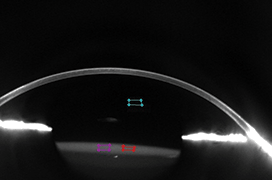Purpose: To report late postoperative opacification of a hydrophobic acrylic intraocular lens (IOL) AcryNovaTMPC 610Y as well as the clinical consequences in patients 10 years after uncomplicated cataract surgery.
Materials and Methods: Medical records were reviewed of 23 patients (26 eyes) with AcryNovaTMPC 610Y implantated between years 2005 and 2007. Next clinical examination was performed 10 years after surgery. We assessed best corrected distance visual acuity (BCDVA), contrast sensitivity (CSV-1000E) and relative opacity of IOL material, (OCULUS Pentacam HR). Results of BCDVA and Pentacam were analysed statistically. One explanted IOL was analysed using anterior segment OCT in vitro and spectroscopic method EDX (Energydispersive X-ray spectroscopy).
Results: Opacification led to a statistically significant reduction in the best corrected distance visual acuity (BCDVA) = (0,95 ± 0,10) versus (0,87 ± 0,20) and to increase of IOL opacity only in some lenses but statistically significant in the average (6,37 ± 2,16)% versus value of (14,22 ± 5,87)%. In the explanted IOL we have documented structural changes of primarily hydrophobic raw material leading to property of hydrophilic one.
Conclusion: Some batches of AcryNovaTMPC 610Y were produced from raw material of poor quality which is the cause of its structural changes and its progressive opacification.

